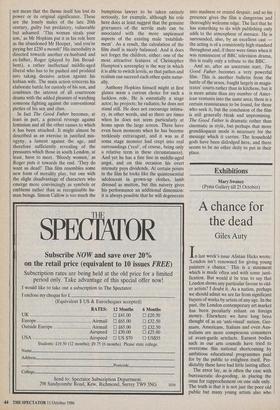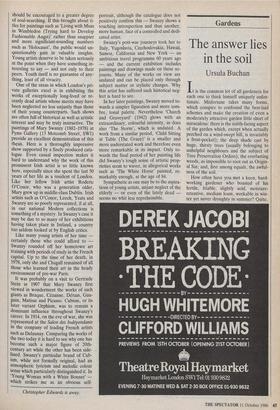Exhibitions
Mary Swanzy (Pyms Gallery till 25 October) A chance for
the dead
Giles Auty
In last week's issue Alistair Hicks wrote: `London isn't renowned for giving young painters a chance.' This is a statement which is made often and with some justi- fication. But would it be true to say that London shows any particular favour to old- er artists? I doubt it. As a nation, perhaps we should admit we are far from significant buyers of works by artists of any age. In the past, the London contemporary art market has been peculiarly reliant on foreign money. Elsewhere we have long been thought of as an 'anti-visual' nation. Ger- mans, Americans, Italians and even Aus- tralians are more conspicuous consumers of avant-garde artefacts. Earnest bodies such as our arts councils have tried to overcome this national shortcoming by ambitious educational programmes paid for by the public to enlighten itself. Pre- dictably these have had little lasting effect.
The error lay, as is often the case with bureaucratic do-gooding, in placing the onus for rapprochement on one side only. The truth is that it is not just the poor old public but many young artists also who should be encouraged to a greater degree of soul-searching. If this brought about ti- tles for paintings such as 'Living with Mum in Wimbledon (Trying hard to Develop Fashionable Angst)' rather than snappier and more significant-sounding numbers such as 'Holocaust', the public would un- questionably gain in valuable insights. Young artists deserve to be taken seriously at the point when they have something in- teresting to say — and not only to their peers. Youth itself is no guarantee of any- thing, least of all vivacity.
One of the areas in which London's pri- vate galleries excel is in exhibiting the works of exceptionally long-lived or re- cently dead artists whose merits may have been neglected no less unjustly than those of their young counterparts. Such shows are often full of historical as well as artistic interest and may be truly instructive. The paintings of Mary Swanzy (1882-1978) at Pyms Gallery (13 Motcomb Street, SW1) provide an excellent demonstration of this thesis. Here is a thoroughly impressive show supported by a finely produced cata- logue. Even casual inspection makes it hard to understand why the work of this prominent Irish artist is so little known here, especially since she spent the last 50 years of her life as a resident of London. Like her fellow Irish artist Roderic O'Conor, who was a generation older, Mary grew up in middle-class Dublin. Irish artists such as O'Conor, Leech, Yeats and Swanzy are so poorly represented, if at all, in our national Modern collections is something of a mystery. In Swanzy's case it may be due to so many of her exhibitions having taken place in Ireland, a country too seldom looked at by English critics.
Like many young artists of her time certainly those who could afford to Swanzy rounded off her hometown art training with periods of study in the French capital. Up to the time of her death, in 1978, only she and Chagall remained of all those who learned their art in the heady environment of pre-war Paris.
It was probably on a visit to Gertrude Stein in 1907 that Mary Swanzy first viewed in wonderment the works of such giants as Braque, Cezanne, Derain, Gau- guin, Matisse and Picasso. Cubism, or its later variant Orphism, was to remain a dominant influence throughout Swanzy's career. In 1914, on the eve of war, she was represented at the Salon des Independants in the company of leading French artists such as Delaunay. Comparing the works of the two today it is hard to see why one has become such a major figure of 20th- century art while the other has been side- lined. Swanzy's particular brand of Cub- ism, while not formally original, had an atmospheric lyricism and melodic colour sense which particularly distinguished it. In `Young Woman with a White Bonnet' which strikes me as an obvious self- Christopher Edwards is away. portrait, although the catalogue does not positively confirm this — Swanzy shows a touching introspection and thus another, more human, face of a controlled and dedi- cated artist.
Swanzy's post-war journeys took her to Italy, Yugoslavia, Czechoslovakia, Hawaii, Samoa, California and New York — an ambitious travel programme 60 years ago — and the current exhibition includes paintings and drawings made on these so- journs. Many of the works on view are undated and can be placed only through subject matter or stylistic changes. Why this artist has suffered such historical neg- lect is hard to see.
In her later paintings, Swanzy moved to- wards a simpler figuration and more som- bre, tonal palette. Nevertheless 'Church and Graveyard' (1942) glows with an extraordinary, colourful intensity, as does also 'The Storm', which is undated. A work from a similar period, 'Child Sitting at Table (The. Grace)' is a smaller and more understated work and therefore even more remarkable in its impact. Only to- wards the final period of her painting life did Swanzy's tough sense of artistic prop- rieties seem to waver, in allegorical works such as 'The White Horse' painted, re- markably enough, at the age of 84. Sympathetic as one may be to the aspira- tions of young artists, unjust neglect of the elderly — or even of the lately dead seems no whit less reprehensible.



























































 Previous page
Previous page